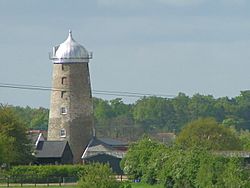Burgh Windmill facts for kids
Quick facts for kids Burgh Windmill |
|
|---|---|

The converted mill, May 2005
|
|
| Origin | |
| Mill name | Burgh Mill |
| Mill location | TM 230 514 |
| Coordinates | 52°06′57″N 1°15′29″E / 52.11583°N 1.25806°E |
| Operator(s) | Private |
| Year built | 1842 |
| Information | |
| Purpose | Corn mill |
| Type | Tower mill |
| Storeys | Seven storeys |
| No. of sails | Four Sails |
| Type of sails | Patent sails |
| Winding | Fantail |
| Auxiliary power | Engine |
| No. of pairs of millstones | Four pairs |
Burgh Mill is a historic tower mill located in Burgh, Suffolk, England. It is a "Grade II listed" building, meaning it's officially recognized as important and protected. This old windmill, once used to grind corn, has now been turned into a home.
Contents
The Story of Burgh Mill
Burgh Mill was built in 1842 by a skilled craftsman named John Whitmore. He was a "millwright," someone who designs, builds, and repairs mills. John Whitmore built this mill for Francis Buttrum. It replaced an older tower mill that was nearby. This mill was the tallest one Whitmore ever built!
In 1919, an 8 horsepower (6 kW) engine was added to help the mill work. The mill continued to grind corn using wind power until 1922. Its machinery was taken apart in 1925 by another millwright, Amos Clarke.
The Mill During Wartime
From July 1940, during World War II, Burgh Mill became an important observation post. It was used by the L.1 post of the Observer Corps. This group watched for and reported the movement of aircraft in the area. The mill's tall height gave them a great view.
The L.1 post worked with two other posts, L.2 at Woolverstone and L.3 at Felixstowe. All of them reported to the 18 Group ROC in Colchester. The Royal Observer Corps stayed at the mill until 1960. That's when a new underground observation post was built nearby.
Later Years and Renovation
By 1997, the mill was in a very poor state. It was "derelict," meaning it was abandoned and falling apart. However, by 2005, it had been restored. It received a new "ogee cap" (a special dome-shaped roof) and a gallery around it.
What Burgh Mill Looks Like
Burgh Mill is a seven-storey tower mill. It has a special "ogee cap" with a gallery, which is like a walkway around the top. When it was working, it had four "Patent sails." These sails would turn the mill, and a "fantail" would automatically keep the sails facing the wind.
The tower is about 23 feet (7 meters) wide inside at the bottom. It narrows to about 13 feet (4 meters) wide inside at the top. The entire tower stands about 57 feet (17 meters) tall to the curb, which is the base of the cap. Inside, the four pairs of millstones, which ground the corn, were located on the third floor.
In 2004, the mill was renovated. Its roof was replaced, and the brickwork was repaired using the original Suffolk white bricks.
Storm Ciara's Impact
On February 9, 2020, a powerful storm named Ciara hit England. The storm was so strong that it ripped the sails right off Burgh Mill.
Who Owned the Mill?
- Francis Buttrum (from 1842)

